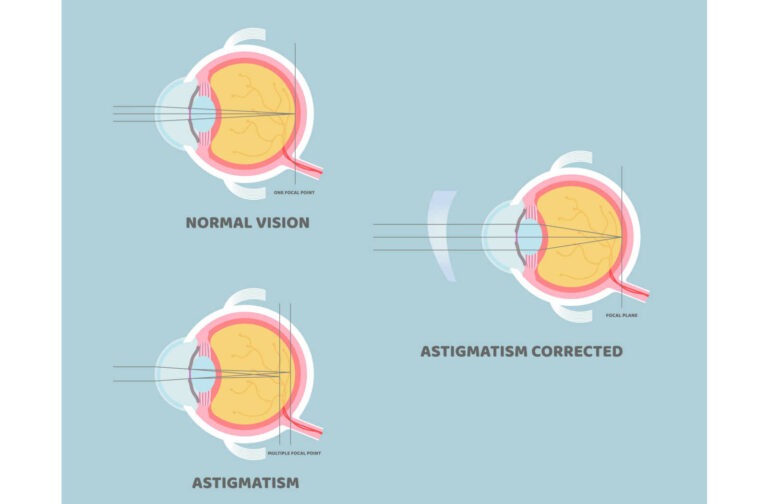The idea that those with astigmatism can’t wear contact lenses has long passed. With our expertise in specialty contact lenses, we can help patients with astigmatism see clearly without glasses. In some instances our patients had been previously told they were not able to wear contact lenses due to the shape of their eyes. However, this was not true; they simply needed an experienced practitioner to help with a proper fitting.
If you want to ditch eyeglasses for contacts, our doctors at Specialty Eye can masterfully fit your eyes with the right lenses. One of the most common types of contact lenses worn by those with astigmatism are toric lenses. Toric contact lenses are designed with a unique shape to help provide clear vision at all distances for individuals with astigmatism.
At Specialty Eye, we can use our advanced training and skill in contact lens fittings to help our patients find a solution for visual clarity that doesn’t rely on glasses.

Contact Lenses for Astigmatism
Astigmatism is effectively caused by a cornea or lens with a different curve. While a typical cornea is spherical, a cornea with astigmatism has mismatched curves, distorting vision at all distances. A lens with a different curvature can also cause similar visual challenges.
In the past, there weren’t many contact lens options for those with astigmatism, and some patients were deemed to have “hard-to-fit” eyes. However, that’s no longer the case. Our doctors at Specialty Eye are skillfully trained to fit contact lenses with unique features to support those with a variety of eye conditions and visual needs.
Toric lenses are a type of contact lens designed with astigmatism in mind. They require a precise fitting, which our doctors can provide, to help you achieve visual clarity without any complications.
What Are Toric Lenses?
Standard contact lenses are spherical to form to the natural shape of the cornea. If you were to cut a soccer ball in half, it would look like a spherical contact lens. A toric lens is shaped differently. Imagine the form of a donut cut in half—it’s rounded but has a flat surface. Toric lenses have a similar surface to manipulate how light enters the eye.
When you have astigmatism, your cornea’s curve can cause light refraction problems on the vertical and horizontal planes, blurring your vision. Toric contact lenses can provide different focusing power on both the vertical and horizontal alignments to help you see clearly.
Astigmatism can combine with other refractive errors, such as myopia (nearsightedness) or hyperopia (farsightedness), and toric contact lens prescriptions can be customized to bring clarity for individuals with complex visual needs created by a combination of refractive errors.
For full correction, toric lenses need to be precisely fit. Our doctors at Specialty Eye are exceptionally knowledgeable in “hard to fit” eyes and helping patients get the right fit for their toric lenses.
Every patient has one-of-a-kind eyes, and contact lenses aren’t one size fits all. Our doctors take the time to examine your eyes closely while considering your other eye concerns before giving individualized recommendations for contact lenses.
Types of Toric Lenses
Toric lenses can offer you several options for sharp vision. Rigid-gas permeable lenses are one of the options we recommend for patients with severe astigmatism. They retain their shape with every blink, which can help keep vision clear without interruption.
Soft toric contact lenses offer flexibility for daily, biweekly, and monthly wear schedules. Since soft contact lenses are designed to form to the eye, some patients enjoy the way they fit more than other types.
At Specialty Eye, we will help you find contacts that meet all your needs for fit, prescription, and lifestyle.

Fitting Toric Contact Lenses
Toric lenses need an expert fit because they must sit at a particular orientation to stay on the eye correctly and maintain consistently clear vision throughout wear.
To help facilitate comfortable, practical wear, toric lenses are designed with specific features to help your lenses maintain position, such as:
Thin-thick zones
Lens truncation, where the bottom end of the lens is cut off slightly
Ballasting, where the lens is thicker or heavier for stability
The ballasting on the contact lens creates a heavier side on the lens. The extra weight is designed to be drawn to the bottom of your eye, so putting your contact lens on the right axis is critical for detailed vision.
The heavier portion of the lens is often marked with a line to eliminate confusion. Make sure that line faces the lower lid (6 o’clock) as you insert your lens to help it settle.
During your visit, we take detailed measurements to ensure the middle axis on the lens is well-balanced and fits precisely. Your measurements can help guide our lens recommendation, and we can provide guidance to help you insert and remove toric lenses.
If you have other eye concerns, such as dry eye, digital eye strain, or severe myopia, we can help you find contact lenses that provide clear vision and support for those conditions too.
Contact Lenses Can Be for Everyone
At Specialty Eye, we have helped many patients with distinct eyes and visual needs find contact lenses that can help them achieve clear vision. Schedule an appointment to discuss your astigmatism and start the journey to glasses-free vision correction with toric contact lenses.

